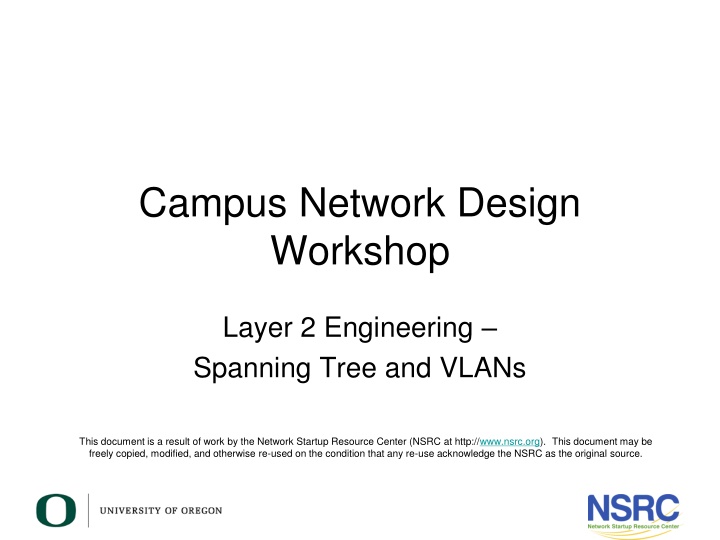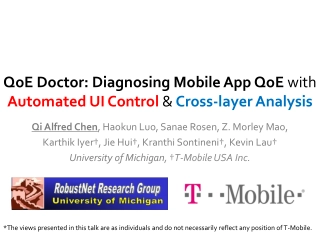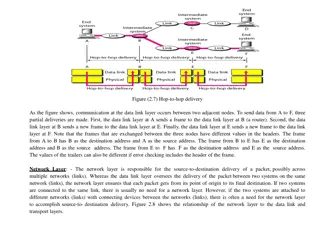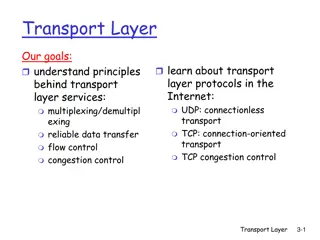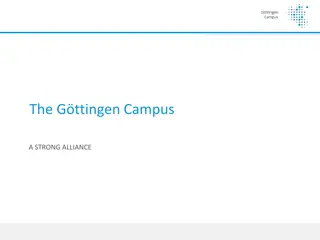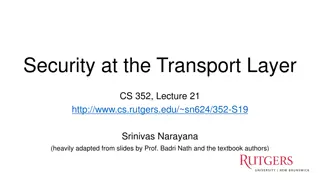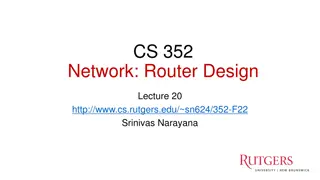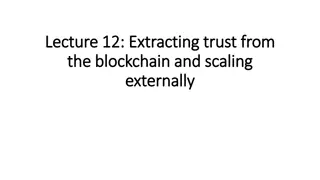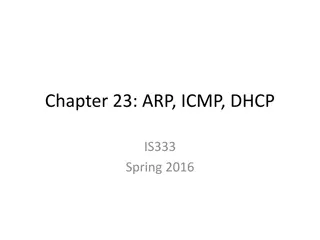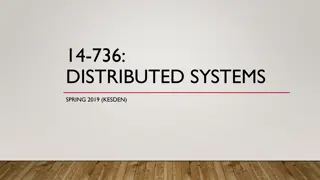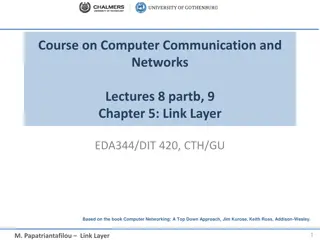Campus Network Design Workshop: Layer 2 Engineering
This document delves into the intricacies of Layer 2 engineering, focusing on Spanning Tree and VLANs in a campus network design workshop. It covers the potential issues of switching loops, ways to avoid dangerous traffic loops, the concept of spanning trees, and the significance of the Spanning Tree Protocol for loop-free connectivity. Detailed diagrams and explanations provide valuable insights for network engineers and enthusiasts.
Uploaded on Feb 15, 2025 | 0 Views
Download Presentation

Please find below an Image/Link to download the presentation.
The content on the website is provided AS IS for your information and personal use only. It may not be sold, licensed, or shared on other websites without obtaining consent from the author.If you encounter any issues during the download, it is possible that the publisher has removed the file from their server.
You are allowed to download the files provided on this website for personal or commercial use, subject to the condition that they are used lawfully. All files are the property of their respective owners.
The content on the website is provided AS IS for your information and personal use only. It may not be sold, licensed, or shared on other websites without obtaining consent from the author.
E N D
Presentation Transcript
Campus Network Design Workshop Layer 2 Engineering Spanning Tree and VLANs This document is a result of work by the Network Startup Resource Center (NSRC at http://www.nsrc.org). This document may be freely copied, modified, and otherwise re-used on the condition that any re-use acknowledge the NSRC as the original source.
Switching Loop When there is more than one path between two switches Switch A Switch B What are the potential problems? Switch C
Switching Loop If there is more than one path between two switches: Forwarding tables become unstable Source MAC addresses are repeatedly seen coming from different ports Switches will broadcast each other s broadcasts All available bandwidth is utilized Switch processors cannot handle the load
Switching Loop Switch A Switch B Node1 sends a broadcast frame (e.g. an ARP request) Switch C Node 1
Switching Loop Switches A, B and C broadcast node 1 s frame out every port Switch A Switch B Switch C Node 1
Switching Loop But they receive each other s broadcasts, which they need to forward again out every port! Switch A Switch B The broadcasts are amplified, creating a broadcast storm Switch C Node 1
Good Switching Loops But you can take advantage of loops! Redundant paths improve resilience when: A switch fails Wiring breaks How to achieve redundancy without creating dangerous traffic loops?
What is a Spanning Tree? Given a connected, undirected graph, a spanning tree of that graph is a subgraph which is a tree and connects all the vertices together . A single graph can have many different spanning trees.
Spanning Tree Protocol The purpose of the protocol is to have bridges dynamically discover a subset of the topology that is loop-free (a tree) and yet has just enough connectivity so that where physically possible, there is a path between every switch
Spanning Tree Protocol Several flavors: Traditional Spanning Tree (802.1d) Rapid Spanning Tree or RSTP (802.1w) Multiple Spanning Tree or MSTP (802.1s)
Traditional Spanning Tree (802.1d) Switches exchange messages that allow them to compute the Spanning Tree These messages are called BPDUs (Bridge Protocol Data Units) Two types of BPDUs: Configuration Topology Change Notification (TCN)
Traditional Spanning Tree (802.1d) First Step: Decide on a point of reference: the Root Bridge The election process is based on the Bridge ID, which is composed of: The Bridge Priority: A two-byte value that is configurable The MAC address: A unique, hardcoded address that cannot be changed.
Root Bridge Selection (802.1d) Each switch starts by sending out BPDUs with a Root Bridge ID equal to its own Bridge ID I am the root! Received BPDUs are analyzed to see if a lower Root Bridge ID is being announced If so, each switch replaces the value of the advertised Root Bridge ID with this new lower ID Eventually, they all agree on who the Root Bridge is
Root Bridge Selection (802.1d) 32768.0000000000AA Switch A Switch B Switch C 32768.0000000000BB 32768.0000000000CC All switches have the same priority. Who is the elected root bridge?
Root Port Selection (802.1d) Now each switch needs to figure out where it is in relation to the Root Bridge Each switch needs to determine its Root Port The key is to find the port with the lowest Root Path Cost The cumulative cost of all the links leading to the Root Bridge
Root Port Selection (802.1d) Each link on a switch has a Path Cost Inversely proportional to the link speed e.g. The faster the link, the lower the cost Link Speed STP Cost 10 Mbps 100 Mbps 100 19 1 Gbps 10 Gbps 4 2
Root Port Selection (802.1d) Root Path Cost is the accumulation of a link s Path Cost and the Path Costs learned from neighboring Switches. It answers the question: How much does it cost to reach the Root Bridge through this port?
Root Port Selection (802.1d) 1. Root Bridge sends out BPDUs with a Root Path Cost value of 0 2. Neighbor receives BPDU and adds port's Path Cost to Root Path Cost received 3. Neighbor sends out BPDUs with new cumulative value as Root Path Cost 4. Other neighbors down the line keep adding in the same fashion
Root Port Selection (802.1d) On each switch, the port where the lowest Root Path Cost was received becomes the Root Port This is the port with the best path to the Root Bridge
Root Port Selection (802.1d) 32768.0000000000AA 1 2 Switch A Cost=19 Cost=19 1 1 Switch B Switch C 2 2 32768.0000000000BB Cost=19 32768.0000000000CC What is the Path Cost on each Port? What is the Root Port on each switch?
Root Port Selection (802.1d) 32768.0000000000AA 1 2 Switch A Cost=19 Cost=19 Root Port Root Port 1 1 Switch B Switch C 2 2 32768.0000000000BB Cost=19 32768.0000000000CC
Electing Designated Ports (802.1d) OK, we now have selected root ports but we haven t solved the loop problem yet, have we The links are still active! Each network segment needs to have only one switch forwarding traffic to and from that segment Switches then need to identify one Designated Port per network segment The one with the lowest cumulative Root Path Cost to the Root Bridge
Electing Designated Ports (802.1d) Two or more ports in a segment having identical Root Path Costs is possible, which results in a tie condition All STP decisions are based on the following sequence of conditions: Lowest Root Bridge ID Lowest Root Path Cost to Root Bridge Lowest Sender Bridge ID Lowest Sender Port ID
Electing Designated Ports (802.1d) 32768.0000000000AA 1 2 Switch A Cost=19 Cost=19 1 1 Switch B Switch C 2 2 32768.0000000000BB Cost=19 32768.0000000000CC Which port should be the Designated Port on each segment?
Electing Designated Ports (802.1d) 32768.0000000000AA Designated Port Designated Port 1 2 Switch A Cost=19 Cost=19 1 1 Switch B Switch C 2 2 32768.0000000000BB Cost=19 32768.0000000000CC Designated Port In the B-C link, Switch B has the lowest Bridge ID, so port 2 in Switch B is the Designated Port
Blocking a port Any port that is not elected as either a Root Port, nor a Designated Port is put into the Blocking State. This step effectively breaks the loop and completes the Spanning Tree.
Designated Ports on each segment (802.1d) 32768.0000000000AA 1 2 Switch A Cost=19 Cost=19 1 1 Switch C Switch B 2 2 32768.0000000000BB Cost=19 32768.0000000000CC Port 2 in Switch C is then put into the Blocking State because it is neither a Root Port nor a Designated Port
Spanning Tree Protocol States Disabled Port is shut down Blocking Not forwarding frames Receiving BPDUs Listening Not forwarding frames Sending and receiving BPDUs
Spanning Tree Protocol States Learning Not forwarding frames Sending and receiving BPDUs Learning new MAC addresses Forwarding Forwarding frames Sending and receiving BPDUs Learning new MAC addresses
STP Topology Changes Switches will recalculate if: A new switch is introduced It could be the new Root Bridge! A switch fails A link fails
Root Bridge Placement Using default STP parameters might result in an undesired situation Traffic will flow in non-optimal ways An unstable or slow switch might become the root You need to plan your assignment of bridge priorities carefully
Bad Root Bridge Placement Out to router Switch B Switch D 32768.0000000000BB 32768.0000000000DD Root Bridge Switch C Switch A 32768.0000000000CC 32768.0000000000AA
Good Root Bridge Placement Out to standby router Out to active router Alernative Root Bridge Root Bridge Switch B Switch D 16384.0000000000BB 12288.0000000000DD Switch C Switch A 32768.0000000000CC 32768.0000000000AA
Protecting the STP Topology Some vendors have included features that protect the STP topology: Root Guard BPDU Guard Loop Guard UDLD Etc.
STP Design Guidelines Enable spanning tree even if you don t have redundant paths Always plan and set bridge priorities Make the root choice deterministic Include an alternative root bridge If possible, do not accept BPDUs on end user ports Apply BPDU Guard or similar where available
802.1d Convergence Speeds Moving from the Blocking state to the Forwarding State takes at least 2 x Forward Delay time units (~ 30 secs.) This can be annoying when connecting end user stations Some vendors have added enhancements such as PortFast, which will reduce this time to a minimum for edge ports Never use PortFast or similar in switch-to-switch links Topology changes typically take 30 seconds too This can be unacceptable in a production network
Rapid Spanning Tree (802.1w) Convergence is much faster Communication between switches is more interactive Edge ports don t participate Edge ports transition to forwarding state immediately If BPDUs are received on an edge port, it becomes a non-edge port to prevent loops
Rapid Spanning Tree (802.1w) Defines these port roles: Root Port (same as with 802.1d) Alternate Port A port with an alternate path to the root Designated Port (same as with 802.1d) Backup Port A backup/redundant path to a segment where another bridge port already connects.
Rapid Spanning Tree (802.1w) Synchronization process uses a handshake method After a root is elected, the topology is built in cascade, where each switch proposes to be the designated bridge for each point-to-point link While this happens, all the downstream switch links are blocking
Rapid Spanning Tree (802.1w) Root DP Proposal RP Agreement Switch Switch Switch Switch
Rapid Spanning Tree (802.1w) Root DP DP Proposal RP RP Agreement Switch Switch Switch Switch
Rapid Spanning Tree (802.1w) Root DP DP RP RP Switch Switch DP Proposal Agreement RP Switch Switch
Rapid Spanning Tree (802.1w) Root DP DP RP RP Switch Switch DP DP Proposal Agreement RP RP Switch Switch
Rapid Spanning Tree (802.1w) Prefer RSTP over STP if you want faster convergence Always define which ports are edge ports
Virtual LANs (VLANs) Allow us to split switches into separate (virtual) switches Only members of a VLAN can see that VLAN s traffic Inter-vlan traffic must go through a router Allow us to reuse router interfaces to carry traffic for separate subnets E.g. sub-interfaces in Cisco routers
Local VLANs 2 VLANs or more within a single switch Edge ports, where end nodes are connected, are configured as members of a VLAN The switch behaves as several virtual switches, sending traffic only within VLAN members
Local VLANs Switch VLAN X VLAN Y Edge ports VLAN X nodes VLAN Y nodes
VLANs across switches Two switches can exchange traffic from one or more VLANs Inter-switch links are configured as trunks, carrying frames from all or a subset of a switch s VLANs Each frame carries a tag that identifies which VLAN it belongs to
802.1Q The IEEE standard that defines how ethernet frames should be tagged when moving across switch trunks This means that switches from different vendors are able to exchange VLAN traffic.
